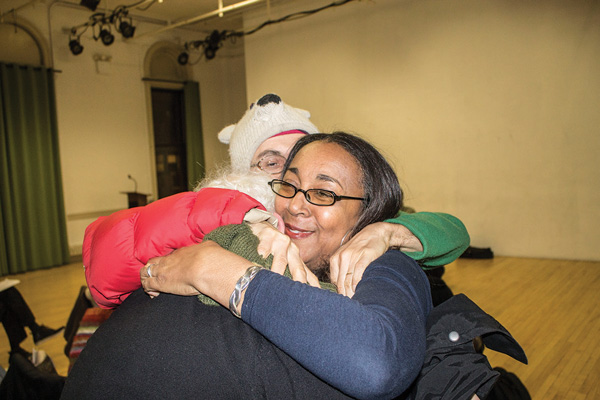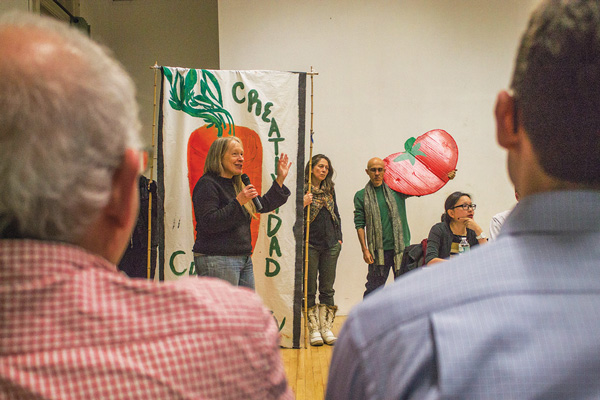
BY ZACH WILLIAMS | Local activists moved one step closer to realizing their ambitions of establishing a community gardens district when Community Board 3 voted 28-1 in support of the plan last week.
Activists are calling on the city to make 38 gardens on municipally owned property into parkland permanently protected from development. Community volunteers, as they do now, would continue to manage these gardens, just as they do in eight other privately owned gardens included within the proposed district.
City Councilmember Rosie Mendez is currently reviewing legislative options for gaining eventual City Council approval for the effort, a spokesperson said in a Feb. 2 e-mail.
“I expected there to be some resistance and I was very surprised at the overwhelming support of this vote. I’m stoked,” said Ayo Harrington, a C. B. 3 member who is leading the push for a community gardens district.
More than 60 letters of support came from elected officials and community organizations, including Mendez, state Senator Brad Hoylman, Assemblymember Deborah Glick, Citizens Committee for NYC and Greenwich Village Society for Historic Preservation, by the time the community board convened at University Settlement on Thurs., Jan. 29. An associated online petition had garnered at least 829 signatures by press time.
Steven Frillmann, executive director of Green Guerillas — the city’s oldest community garden organization — issued a statement on Dec. in support of the plan.
“The dozens of community gardens that now thrive in Community Board 3 are testaments to the skill, determination and creativity of community gardeners,” his statement said. “They provide countless service to their neighbors of all ages — healthy green spaces, recreation, food, cultural activities and educational opportunities.”
The city-owned gardens are seen as vacant lots by city agencies, developers and housing advocates — development sites for future affordable or market-rate housing.
With rents continuing to rise in the East Village and Lower East Side, and with Mayor de Blasio’s ambitious new affordable-housing plan, Harrington said she expected some of her colleagues at C.B. 3 might regard the establishment of the gardens district as limiting the potential for the future construction of affordable housing in the area.
“The gardens are taking too much space and you know that’s the only way we can continue affordable housing in the neighborhood,” said Zulma Zayas, the only C.B. 3 member to vote against the board’s resolution.
Many of the city-owned lots became community gardens after being abandoned by their owners during the 1970s and ’80s. Activists said the establishment of the district would recognize the work they did as they transformed garbage-strewn properties into inviting community green spaces.
There were once more than 60 such community gardens within the C.B. 3 boundaries, but only 46 now remain, according to the board’s resolution.

Development claimed these lost green oases, spurring community gardening activists to search for a means to protect the remaining ones, according to activists.
Last fall, supporters of Siempre Verde Garden, at Stanton and Attorney Sts., stymied an effort by the city’s Department of Housing Preservation and Development to get C.B. 3’s approval for a 16-unit housing project that would have displaced the garden from its two adjacent city-owned parcels.
Mayor Bill de Blasio’s election last year created an opportunity to secure the future of all the surviving gardens through the community board and City Council, said Harrington. Outreach will continue in upcoming weeks to school principals, parents associations and local businesses, she added.
Activists said in a statement following the board’s vote that they want to preserve the legacy of a “homegrown, gritty” neighborhood within the proposed community gardens district, rather than replacing that with a “manicured version.”
For activists who have battled the city in the past over the sovereignty of the city-owned parcels, the future looks bright.
Beyond the advantages of the green spaces lies an economic potential, according to Claire Costello of the Lower East Side’s Siempre Verde Garden. Partnerships could arise between gardeners and the businesses in the increasingly trendy neighborhood, she suggested.
“I think it s going to be a very unique tourist attraction for the Lower East Side and East Village,” she said. “The combination of those gardens and their history just adds an awful lot to the community.”

















